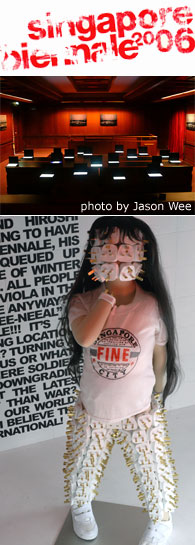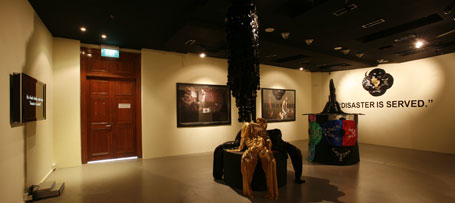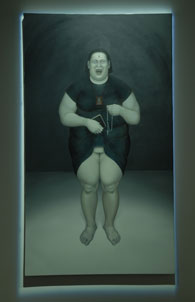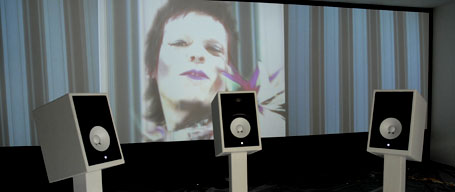Ever since Michelangelo covered the Sistine Chapel ceiling with macho Maries, the art world's been full of gay (or bisexual) people. Botticelli, da Vinci, Caravaggio, Warhol, Frida Kahlo, Pierre and Gilles... the list of names is long and scandalous.

Top: Singapore artists Jason Wee's 1987 and Brian Gothong Tan's ''We Live in a Dangerous World.''
Singapore's a real newcomer to the biennale scene (fyi, the word is pronounced "bee-en-nah-lay" and just means "once every two years" in Italian). The oldest and most important biennale is held in Venice, but there are comparably fabulous ones all over the world, in Sao Paolo in Brazil, Sharjah in the United Arab Emirates, and recently Jakarta in Indonesia, for starters. The concept of the Singapore Biennale was proposed back as 1999, but the project only got funding this year as part of the country's investment in the recently concluded World Bank/International Monetary Fund meetings in Singapore (which deserves a whole other article - go see Fridae columnist/ social commentator/ gay activist Alex Au's report for more information).
As a volunteer with the Biennale, I've had the pleasure of meeting other gay staff members and volunteers, hearing snippets of gossip about which studly young muralists have already found steady Singapore boys to hang out with before the opening. I observed the progress of installations by openly gay Singapore artists Jason Wee and Brian Gothong Tan - click on each of their names to read their interviews with Fridae about their earlier art exhibitions. While we won't interview them this time round, I'd urge everyone to check out their works - Jason's "1987" references both his grandmother's death in 1987 and the ISD arrest of 20 people on suspicions on Marxist conspiracy the same year, while Brian's "We Live in a Dangerous World" assaults viewers with a world of mock-PAP mannequins and videos of a "drag queen" Annabel Chong condemning the death penalty.
Sadly, no lesbian or bisexual women artists were featured in the Biennale, though feminist artists had a fair representation, with works by Amanda Heng of Singapore, Amal Kenawy of Egypt, and Jenny Holzer and Barbara Kruger of the USA. It's a shame: there's a growing number of lesbian artists in Singapore, especially photographers and video artists, who've already made a name for themselves - and surely, hundreds more overlooked in the region and beyond.
Fridae chose, in the end, to profile the works of three queer-identified male artists from the Asia-Pacific region: Yason Banal, José Legaspi and Philip Brophy.

Born 1972, Philippines, lives and works, Manila
Dancing Sons (Tropic of Virgo) (above) , 2006, mixed media installation, City Hall
"I'm interested in the idea of the tropical Gothic," Yason explains. "The Filipinos have been judged as the seventh happiest people in the world, and I don't see that as a compliment at all. I wanted to bring out the dark side of tropical culture - we have a lot of visionaries and faith healers, people who apparently see the Virgin Mary or crucify themselves like Jesus Christ."
As a young artist, Yason's consequently tried to recreate of the disturbing atmosphere of tribal religious ecstasy in various spaces around the world. His installation in Singapore is truly multidisciplinary - it includes videos, staged photography, a mounted animal skull with the slogan "Disaster is Served," and even performance - I almost had the chance to participate in his show as a living artwork, wearing swimming trunks and a black wig over my face, standing in his gallery space as one of his eerie, silent "figurines."
His wigs are patterned after the fake hair of the Santo Niños, the baby Jesus dolls used in Catholic processions ("They're so queer, they look like Barbie with their makeup," he says.)
Yason's dedicated to drawing on images from different cultures - while inspired by Goth culture during his teaching days in London Metropolitan University, he's also borrowed from Japanese porn and, disco and death metal music. His human figurines were featured as part of the Biennale's Opening Event, accompanying the death metal band Bastos Con Diabolitos onstage.
"I've got a hesitance and wariness towards the gay community now, because I feel that it has lost its criminal edge," he laments.
"Yuppie culture annoys me; everyone's so happy and consumer-oriented, so Hollywoodised and McDonaldised. Culture is replicating itself without being really critical. We need extreme things to feel something again."

Born 1959, Philippines, lives and works, Manila
Saint Thelma (right) and other paintings, 2006, oil on canvas and pastel on paper, National Museum
José started out training to be a doctor, but he's since moved on to something more gruesome - his paintings and drawings routinely explore violence, mutilation, religion and desire. Walk into his exhibition space and the first thing you'll see is "Saint Thelma," a portrait of a fat, vampiric nun lifting her skirts to expose her vulva.
José's quite frank about the emotional roots of such tortured paintings. "My source of inspiration comes directly from the confines of an unstable family home, and indirectly from living in a politically charged and poor, unstable society; a religious society where Christian fanaticism is practiced," he declares.
Critics have often read the artist's transgressive works as statements for gay liberation in a conservative society. But in fact, José doesn't believe his sexual identity has had a big impact on his work. "It just so happens I am a homosexual," he says.
"If I were heterosexual and experienced the same experiences, I still would be dwelling on the same matter, drawing heterosexual acts." And having traveled and exhibited in America, Austria, and Japan, he actually feels lucky that homophobia in the Philippines is nowhere as violent as in supposedly 'liberal' places like California.
Far from being stridently anti-religion, José actually expresses a yearning for faith in his pastels, also featured in this display. Here, his style manifests itself as desolation rather than horror - pieces such as "The Corridor" and "Morgue," show ominous, vacant spaces. These form a part of his unfinished project of portraying empty spaces as the opposite of churches: gathering places for potential belief, long since abandoned.
As he explains, "It's like, 'I believe, but then there is nothing to see. They have all left.'"

Born, 1959, Australia, lives and works, Melbourne
Fluorescent (above), 2006, three-channel video installation
"'Controversy' is such a '60s concept," Philip yawns. "Unless it's a song by Prince in the '80s - then it's cool."
A true cultural chameleon, Philip shifts between the worlds of art, film, music and academia. At the age of 18, he co-founded experimental arts group "→↑→" (pronounced "Tsk Tsk Tsk"), which churned out cutting-edge music, video and theatre on a shoestring budget all over Australia - today, he lectures and publishes essays in a variety of fields, from pop record production to Japanese manga and anime, glorying in the blurring of lines between high and low art. And, just to complicate matters, he identifies not as gay or bisexual but "polysexual."
"I don't adhere to any binaries, and I much prefer the idea of being conflicting things at the same time," he says. "Sexual politics has a long modern history of being very binary - 'us-versus-them' - promoted by dominant and fringe sexual practices. I think everybody is ultimately a paraphiliac, and the more un-human one can become with sex, the
better."
His new work for the Biennale is a music video that pays homage to the era of Glam Rock in the '80s. Philip dresses up as a sexually slippery, David Bowie-esque rock star, complete with feathers, leather and kinky boots, singing a song of his own composition. You'd think this was a private salute to a vanished era of sexual freedom, but you're wrong - there's a focus instead on disconnection between sound and image, as fragments of his song and image appear and disappear at intervals, forcing the brain to reinterpret the link between visual and aural stimuli.
"Fluorescent is an acknowledgement of Glam Rock as an epoch where the 'Self' became completely fictitious and disposable." Philip asserts.
"I frankly have zero interest in myself in any way. To reverse the humanist lament of Charmagne: ''I've never been to 'me' and I'm in paradise.'' I don't like to remain separate from culture: I like to sink and drown in it, to mutate and merge with it. Media is the sheen of the germ-like spread of culture, so I'm that sheen."
Confused? Don't be embarrassed; so are most of the people Philip encounters. "I'm never one for making things simple for an audience," he laughs. "Let them sweat it out a bit."
The Singapore Biennale will be held from 4 September to 12 November 2006. The main exhibition sites are City Hall, the National Museum and Tanglin Camp. Single entry passes, valid for all three sites, are S$5, unlimited entry passes are S$25. Sites are open 10am to 6pm Tuesday: 1pm to 6pm; Friday: 10am to 9pm (City Hall and Tanglin Camp), 10am to 6pm (National Museum). Free entry on Fridays 6pm to 9pm. For more information, including schedules for free on-site tours and walking tours for wider events, visit www.singaporebiennale.org.
Ng Yi-Sheng is (among many things) a volunteer tour guide for the Singapore Biennale.
